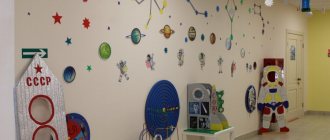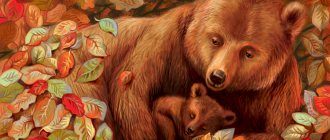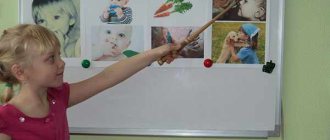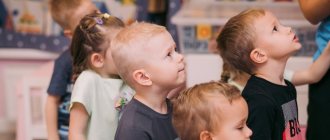Work program “Child and the world around us” senior group for the 2016-2017 academic year
Explanatory note
The work program “Child and the world around us” for children of the senior group - the educational area “Cognitive development” and “Socio-communicative development” - was compiled on the basis of the author’s planning “Classes on familiarization with the world around us”, “Mosaic-Synthesis”, 2011. and the author’s program “Introduction to Nature in Kindergarten.” A list of used literature on environmental education of children is attached.
This program is designed to work with children aged 5 to 6 years. The program is designed for 30 lessons per year, the duration of one lesson is 25 minutes.
The number of classes planned in the work program and in the calendar plan of educational work may differ slightly due to national holidays, non-working days, holidays and entertainment within the garden and quarantine measures. If there are not enough planned classes, classes are taken to consolidate the material covered.
In the sixth year of life, introduction to the objective world involves the formation of ideas about the object as such and about the creation of human thought and the result of labor activity. In introducing children to the phenomena of social life, the core theme is the life and work of people. The basis of familiarization with the natural world is helping the child to understand himself as an active subject of nature.
The implementation of program tasks is carried out in the process of both everyday communication with children and in special classes, frontal and group. Children are introduced to the diversity of the world around them, but at each age stage, the interests and preferences of preschoolers relate to one or another area of activity. Therefore, the schedule of classes provides for a reasonable alternation of them throughout each month.
Purpose of the program: Expand children's understanding of their native country, about public holidays (March 8, Defense of the Fatherland Day, Victory Day, New Year, etc.). Foster love for the Motherland. Expand ideas about your native land, city, village.
To consolidate ideas about objects and phenomena of the surrounding reality, flora and fauna. Form the beginning of an ecological culture.
Develop the ability to observe, analyze, compare, and identify characteristic, essential features of objects and phenomena of the surrounding world.
Develop the ability to observe, analyze, compare, and identify characteristic, essential features of objects and phenomena of the surrounding world. The basis for introducing a child to the natural world is to help the child become aware of himself as an active subject of nature.
2. Calendar - thematic planning
| Month | Subject | Targets | Methodological support |
| September | 1.Items that facilitate human work in everyday life. | To form children’s ideas about objects that facilitate human work in everyday life; pay attention to the fact that they serve a person, and he must treat them with care; reinforce the idea that objects have different purposes. | O. V. Dybina Page 20 |
| September | 2.My family | Continue to develop children's interest in family and family members. Encourage the names and patronymics of family members to be named; talk about their professions, what they are like, what they like to do at home, what they do at work. Cultivate a sensitive attitude towards the closest people - family members. | O. V. Dybina Page 22 |
| September | 3. “Whether in the garden or in the vegetable garden” | Expand children's understanding of the diversity of the plant world. Learn to recognize and correctly name vegetables, fruits and berries; to form ideas about the benefits of vegetables and fruits, about the variety of different dishes made from them. Expand your understanding of how to care for garden plants. | Page 36 |
| September | 4. “Ecological trail in autumn” | Expand your understanding of the objects of the ecological trail and seasonal changes in nature. To form an aesthetic attitude towards the surrounding reality. Systematize knowledge about the benefits of plants for humans and animals. | Page 38 |
| October | 1. What does the subject tell about itself? | Encourage children to highlight the features of objects: size, shape, color, material, parts, functions, purpose; continue to improve the ability to describe objects by their characteristics. | O. V. Dybina Page 24 |
| October | 2.About friendship and friends | Expand knowledge about peers, reinforce the rules of a friendly attitude towards them: share a toy, talk politely, affably, if one of the children is sad, talk to him, play, always help, help out your friends. | O. V. Dybina Page 25 |
| October | 3. Take care of animals! (October 4 is World Animal Day) | Expand your understanding of the diversity of the animal world. Strengthen ideas about animals of your native land. Expand your understanding of the relationships between animals and their environment. Cultivate a conscious attitude towards the natural world. Give basic ideas about ways to protect animals. Develop creativity and initiative. Ability to work in a team in the process of creating a “Take care of animals” poster. | Page 41 |
| October | 4. Walk through the forest. | Expand your understanding of the diversity of the plant world. Talk about the species diversity of forests: deciduous. coniferous. Mixed. Learn to name the distinctive features of trees and shrubs. Develop a caring attitude towards nature. Systematize knowledge about the benefits of forests in the lives of humans and animals. | Page 42 |
| October | 5.Paper collector | Expand children's understanding of different types of paper and its qualities; improve the ability to identify objects based on material characteristics. | O. V. Dybina Page 27 |
| november | 1.Kindergarten | Talk to the children about why the kindergarten is called that way (because they “grow”, care for and look after them like plants in a garden). Show the social significance of the kindergarten: parents work, they are calm, because in their absence the kindergarten staff takes care of the children. Kindergarten employees should be thanked for their care, respected for their work, and treated with care. | O. V. Dybina Page 28 |
| november | 2. Autumn | To consolidate knowledge about seasonal changes in nature. Expand your understanding of vegetables. Fruits and mushrooms. Introduce the traditional folk calendar. Introduce to Russian folk art. To form an aesthetic attitude towards nature. Create a positive emotional mood. | Page 45 |
| november | 3.Feathered friends | To form children's ideas about wintering and migratory birds. Learn to solve riddles. Develop interest in the world of birds, curiosity. Give an idea of the importance of birds for the environment. Develop attention and creativity. To create in children a desire to take care of birds. | Page 49 |
| November | 4. Tanya doll’s outfits | Introduce children to different types of fabrics, pay attention to individual properties of fabrics (absorbency); encourage the establishment of cause and effect relationships between the use of fabrics and the time of year. | O. V. Dybina P.31 |
| December | 1. Games in the yard | Introduce children to the basic basics of life safety; discuss possible dangerous situations that may arise when playing in the yard of the house, sledding, skiing; introduce the necessary precautions and the telephone number “03” (teach how to call an ambulance). | O. V. Dybina Page 32 |
| December | 2. Let's feed the birds | Expand your understanding of the wintering birds that live in our area. Learn to recognize and name birds by appearance, develop a desire to watch birds without disturbing them; take care of birds in winter. Reinforce knowledge about the habits of birds. Form emotional responsiveness. | Page 53 |
| December | 3. How animals help humans | Expand your understanding of animals from different countries; about how animals can help humans. Show ways of keeping animals domesticated by humans. Develop an interest in the animal world. Develop a caring attitude towards animals and a desire to care for them. | Page 55 |
| December | 4.In the world of metal | Introduce children to the properties and qualities of metal; teach you to find metal objects in your immediate environment. | O. V. Dybina Page 34 |
| January | 1.Visiting the wardrobemaid | Introduce children to the business and personal qualities of a wardrobe maid. To lead to an understanding of the holistic image of the wardrobe maid. Develop an emotional, friendly attitude towards her. | O. V. Dybina Page 35 |
| January | 2. Winter natural phenomena | Expand children's understanding of winter changes in nature. Reinforce knowledge about the winter months. Activate vocabulary (snowfall, blizzard, frost, frost). To teach to gain knowledge about the properties of snow in the process of experimental activities. Develop cognitive activity and creativity. | Page 57 |
| January | 3. 1.Journey into the past of the phone | Introduce children to the history of the invention and improvement of the telephone; establish rules for using the telephone; develop logical thinking. Smartness. | O. V. Dybina |
| January | 4. Ecological trail in the kindergarten building | Expand children's understanding of the objects of the ecological trail in the kindergarten building. Teaches to recognize and name familiar plants and animals. Expand your understanding of how to care for plants and animals. Develop coherent speech. Develop a desire to help adults care for plants and animals. Develop an interest in the natural world, an aesthetic attitude towards the surrounding reality. Develop a desire to act as a guide at points along the ecological trail. Develop creative activity. | Page 59 |
| February | 1.Song of the bell | To consolidate children's knowledge about glass, metal, wood, and their properties; introduce the history of bells and bells in Rus' and other countries. | O. V. Dybina Page 37 |
| February | 2.Russian army | Continue to expand children's understanding of the Russian army. Talk about the difficult but honorable duty to defend the Motherland, protect its peace and security. Tell that soldiers serve under the leadership of officers. Introduce military professions - border guard, sailor, pilot, etc. Tell that in order to become an officer, you need to graduate from a special school, know and be able to do a lot, be strong, resilient, brave, resourceful. | O. V. Dybina Page 38 |
| February | 3. Flowers for mom | Expand knowledge about the variety of indoor plants. Give basic ideas about plant propagation by vegetative means. learn to plant seedlings of indoor plants.. Form a caring and attentive attitude towards loved ones (mother) | Page 62 |
| February | 4.Excursion to the zoo | Expand children's understanding of the diversity of the animal world, that man is part of nature, and he must preserve, protect and defend it. Form ideas that animals are divided into classes: insects, birds, fish, animals (mammals). Develop cognitive interest, curiosity, emotional responsiveness. | Page 63 |
| March | 1. Journey into the past of the light bulb | Introduce children to the history of the light bulb; evoke a positive emotional mood and interest in the past of this subject. | O. V. Dybina Page 41 |
| March | 2.Visiting the artist | To form an idea of the social significance of the artist’s work, its necessity; show that the products of the artist’s labor reflect his feelings, personal qualities, and interests. | O. V. Dybina Page 43 |
| March | 3. The world of indoor plants | Expand your understanding of the variety of indoor plants. Teaches you to recognize and correctly name indoor plants. Talk about professions related to caring for indoor plants. To consolidate knowledge about the basic needs of indoor plants, taking into account their characteristics. Improve plant care skills. Develop a desire to help adults care for indoor plants. Cultivate a caring attitude towards plants. To form an aesthetic attitude towards nature. | Page 66 |
| March | 4.Water resources of the Earth | Expand children's understanding of the diversity of water resources: springs, lakes, rivers, seas, etc., about how a person can use water in his life; about how to use water resources economically. Expand your understanding of the properties of water. Strengthen knowledge about the water resources of your native land; about the benefits of water in the life of humans, animals and plants. | Page 69 |
| April | 1.A journey into the past of the vacuum cleaner | Arouse children's interest in the past of objects; lead to the understanding that a person invents and creates various devices to make work easier. | O. V. Dybina Page 45 |
| April | 2. Russia is a huge country | To form the idea that our huge, multinational country is called the Russian Federation (Russia), there are many cities and villages in it. To get from one end of the country to the other, for example, from the city of Kaliningrad to the city of Vladivostok, you need to travel by train for several days. Introduce Moscow - the main city, the capital of our Motherland, and its attractions. | O. V. Dybina Page 46 |
| April | 3. Forests and meadows of our homeland | To consolidate knowledge about the diversity of the flora of Russia. Form ideas about plants and animals of forests and meadows; about the relationship between flora and fauna. Foster a caring attitude towards nature. To form an aesthetic attitude towards the surrounding reality. | Page 71 |
| April | 4. Spring suffering | Consolidate knowledge about spring changes in nature. Expand children's understanding of the features of agricultural work in the spring. Foster a respectful attitude towards people involved in agriculture. Activate children's vocabulary (spring country, harvester, agronomist, etc.). Develop curiosity, creativity, initiative. | Page 73 |
3. Planned intermediate results of mastering the program
—
distinguishes and names types of transport, objects that facilitate human work in everyday life;
—
classifies objects, determines the materials from which they are made;
—
knows the name of his native village, country, its capital;
—
names the seasons, notes their features;
—
knows about human interaction with nature at different times of the year.
4. Monitoring children’s achievement of the planned results of mastering the program
The object of monitoring is the achievements of children.
Frequency of monitoring -
2 times a year, months: September and May.
| Criteria | Child's full name |
| September | May |
| The child can: | |
| distinguishes and names types of transport, objects that facilitate human work in everyday life | |
| classifies objects, determines the materials from which they are made | |
| knows the name of his native village, country, its capital | |
| knows about human interaction with nature at different times of the year; | |
| names the seasons, notes their features |
1 - beginning of the year, 2 - end of the year. Development level assessment: 1 point – most components are underdeveloped; 2 points - individual components are not developed; 3 points – appropriate for age, 4 points – high
Get text





